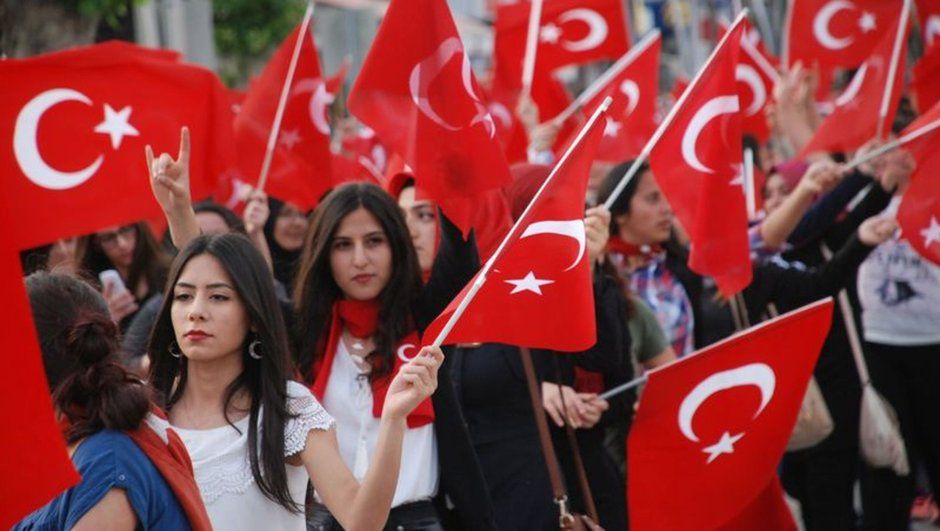“White Turks”, “Black Turks” and why not “Grey Turks”? It is well known, in a society, that the presence of “Blacks” does not require the “physical” presence of Blacks! Each society creates within itself a group that is despised, oppressed and considered inferior, both in terms of cultural and financial capital.
The expression “white Turks” appeared in Turkish political jargon in the 1990s, when the Turkish bourgeoisie, itself of rural origin until the 1930s, discovered the second generation of rural people born in urban areas, coming from of the rural exodus of the 1960s and 1970s. Thus, from the 1990s, in the Turkish press, the term “white Turks” began to designate an ill-defined category of urban, westernized Turks, adopting at least some aspects of Western life, largely secularized and having kept only the festive aspects of the Muslim religion, consuming alcohol but rarely (apart from a tiny minority of the elite) pork.
The dichotomy in Turkey between “White Turks” and “Black Turks” appears with the concomitance of neoliberal state policies and mass migration, and especially with the birth of a new generation of rural origin in the cities. At the same time, Turkish society was changing from a traditional society with a local economy to a national or even international market society. Even if the questions of popular class / oppressed class are determining in the creation of this dichotomy, ordinary racism is not to be neglected either, especially with regard to the Kurds.
In reality, this expression is used in most cases hollow, in opposition to another group. A quick analysis of the Turkish press of the 2000s shows that on reflection, the “Black Turks” are three interpenetrating groups:
1. The “new urbanites” who do not know good manners, of rural origin, rustic and uneducated, misogynistic and macho. This typology is often described by liberal authors, Kemalists who adopted the Western way of life while remaining nationalist. The best example is the image of “the man scratching his belly”, an image that was instrumentalized by the new bourgeois as the example of ostracism and oppression they would suffer from the Kemalist liberals . “The man who scratches his belly” likes his big belly, puts his leg under his buttocks to sit down. He gets angry at unveiled women, doesn’t like TV news but watches variety shows, doesn’t read a book but consults his Sheikh. In politics he knows nothing and categorizes the leaders according to whether they are (good) Muslims or not, and he admires them even if they are corrupt.
2. Conservatives in general, related or not to the previous category, religious, at least superficially adopting Sunni Muslim behavior. This category considered itself for decades, especially after the 1970s, as victims of discrimination, in particular because of the wearing of the headscarf by women and because of the pressure of the military-bureaucratic elite. So much so that when this category gained power in 2002 with the arrival of the AKP in government, the expression “White Turks” became an insult. Recep Tayyip Erdoğan himself declared in 2003 that he represented the “black Turks”, monopolizing the incarnation of the conservative and religious class.
3. The Kurds, who became visible in the cities from the 1990s, with mountainous manners and a language apart and above all an organization either tribal or politicized through political parties or violent organizations. The 2000s coincided with the period when a fringe of the liberal left took up the cause of the Kurdish question, legitimizing their presence in urban spaces and fighting the state apparatus that oppressed them.
It should be noted, however, that among these “black Turks” the conservatives have created their own bourgeoisie and their own ruling class, both financial and political, to such an extent that those who are described as “white Turks” consider themselves today as oppressed by the religious while continuing to despise them. The only constant in this classification is the condition of the Kurds, often seen as inferior both by the Kemalist and secularist elite and by conservative Turks.
To be completely fair, to these two ideal-typical* categories, it is perhaps necessary to add a third. These Westernized Turks, from middle-class families, belonging to radical or liberal left movements, but who, over the generations, have become antitheses to the white/black dichotomy. They and they refuse the discrimination suffered even by those who are not from their social group. Defend the Kurds without being Kurds, defend the LGBT without being Kurds, defend the working classes without having worked once with their hands. These Turks, who perhaps present the 50 shades of grey, so diverse they are, were at Gezi Park in June 2013. They are young, they are urban but dream of ecology, equality, anti-machismo and of anti-nationalism. And, at least for now, they have only partially found political expression. The Republican People’s Party (CHP) is considered too nationalist, or the Justice and Development Party (AKP) too Islamist and authoritarian. Only certain fringes of the Peoples’ Democratic Party (HDP) were able to garner sympathy from these groups, but with the HDP retaining its “Kurdish” character and being constantly criminalized by a controlled press, it is difficult to see all the “Grey Turks” join…



